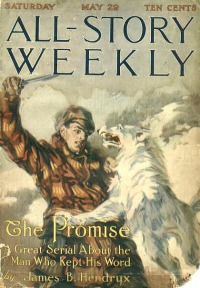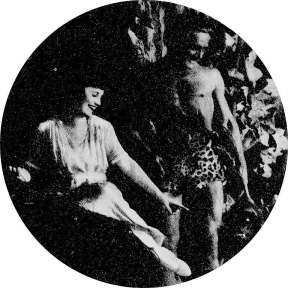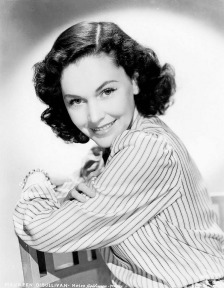
Official Edgar Rice Burroughs Tribute and Weekly Webzine Site Since 1996 ~ Over 15,000 Webpages in Archive Volume 7155a 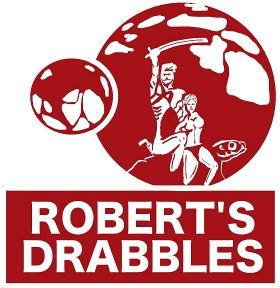 |
ERB 100-Word Drabbles
MAY II Edition :: Days 16 - 31
See Days 1-15 at ERBzine 7155
by Robert Allen Lupton
With Collations, Web Page Layout and ERBzine Illustrations and References by Bill Hillman
SYSTEM FAILURE
May 16: On this date in 1977, Viola Lynn Collins was born in Houston, Texas. Lynn has had a successful film career and appeared in films and television series from several genres. Some of her many fantasy roles, including Dejah Thoris in "John Carter," Dawn Green in “True Blood” and Kayla Silverfox in X-Men movies. She also appeared in the science fiction films “Rim of the World,” and “Beneath Us.” (Spoiler alert) She is currently appearing as a murderess on season six of “Bosch.”
“System Failure” is today’s Edgar Rice Burroughs inspired drabble.
![]()
SYSTEM FAILURE
“I looked fabulous, as I should. Woola looked small, but he was cute and endearing. I can’t imagine why your hair was longer than mine.”
“It wasn’t.”
“Was too. Play the movie again.”
Carter tried to stream the movie again, but it didn’t
reload. It was being streamed by a powerful network in Texas.”
“Dejah, it’s not working.”
“You say that because you know I’m right. Our subscription’s
current. Contact them.”
Carter turned on the Gridley Wave. “Houston, we have
a problem.”

TWISTED TITLES
May 17: On this day in 1962, Canaveral Press republished three ERB stories, but the titles for two of them were changed just a bit. Instead of "The Moon Maid," they retitled it "The Moon Men." "A Fighting Man of Mars," was titled correctly on the dust jacket cover, but it reads "The Fighting Men of Mars" on the spine. The actual Fighting Man book has a unique typeface on the DJ spine. The same typeface is used on the spine of the book itself, but the title is rendered correctly on the book. "The Monster Men" was the third book and its title made it through the Canaveral process just fine. All three titles were illustrated by Mahlon Blaine.
“Twisted Titles” is today’s Edgar Rice Burroughs’ inspired drabble.
![]()
TWISTED TITLES
“It looks OK.”
“It’s not. It says “Fighting Man” on the front and
“Fighting Men” on the spine.
“It takes at least two men to fight.”
“That’s not funny.”
“Richard, you re-titled “The Moon Maid” as the “The
Moon Men.” Maybe, the letterer though you changed all three new titles.
“At least he didn’t change “The Monster Men” to the
“The Monster Mash.”
“Too bad. It would have been a graveyard smash!”
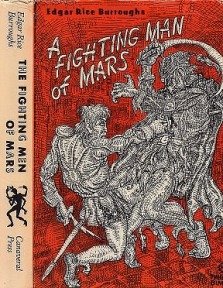
CAREER CHANGER
May 18: On this day in 1915, Florence Eugene Watson was born in Los Angeles, California. She is best known for her role as a mysterious secret agent in "The New Adventures of Tarzan" (1935), filmed on location in the highlands of Guatemala. This was one of the few Tarzan movies without a "Jane" and Ula Holt came as close as anyone to being the female lead.
While filming the Burroughs-Tarzan Enterprises production on location in Guatemala, ERB's business partner Ashton Dearholt (producer/actor) fell in love with his leading lady, whom he had named Ula Holt. (Dearholt occasionally acted under the name, Richard Holt. When Dearholt returned to Hollywood with Miss Holt in tow, Mrs. Dearholt, silent screen actress Florence Gilbert, was granted a divorce and eventually married longtime family friend Edgar Rice Burroughs.
Her role as Ula Vale in ‘The New Adventures of Tarzan,” also released as “Tarzan and the Green Goddess,” appears to be her only credit screen appearance. IMBd lists an uncredited role in 1934’s “Adventure Girl,” A horribly bad jungle drama. A self-styled adventuress, retells her "true" adventures in the wilds of Guatemala. Her overacting is a sight to see. Holt played Princess Maya. If her decision to not be listed in the credits was an effort safe her career from this film, it didn’t work.
Dearholt died at age 48 on April 27, 1942. Holt married William Anderson Gleason and took the name Jewel Watson Gleason, bearing a son and daughter.
She died in Clay County, Florida on January 18, 1982 and is buried in Oakwood Cemetery in Charlottesville City, Virginia, alongside her second husband, who died in 1986.
“Career Changer” is today’s Edgar Rice Burroughs inspired drabble.
![]()
CAREER CHANGER
“Aston has high hopes. He and I will marry back in
the states.”
“It’s too bad that when men marry, they don’t change
their names.”
Bruce, this is movie land. Use any name you want.
If I make another film, I’ll call myself, Jewel.”
“Renaming yourself jewel, won’t make remember your
lines. I could call myself Franklin Delano Roosevelt, but it won’t make
me President.”
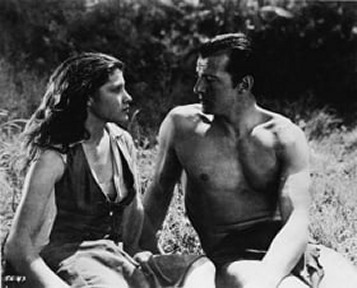
BURNING BRIGHT
May 19: On this day in 1905, Natalie Kingston who starred as Jane in "Tarzan the Tiger (1929)," was born as Natalia Ringstrom in Vallejo,Sonoma County, California. She was the great-granddaughter of General Mariano Vallejo, who surrendered California to General John C. Fremont. A maternal great grandfather was Agoston Harazthy, who is frequently acknowledged as the founder of California’s wine industry.
She starred as Mary Trevor in the lost movie serial, “Tarzan the Mighty,’ and was the third actress to play Jane, appearing in “Tarzan the Tiger” with Frank Merrill as Tarzan in both productions.
“Burning Bright” is today’s Edgar Rice Burroughs inspired drabble.
![]()
BURNING BRIGHT
“I’ve no idea. My costume’s a torn dress and we’ll
both be wearing those stupid headbands.”
“No tigers in Africa. Leopards, lions, cheetahs, yes,
but no tigers.”
‘Don’t complain, Frank. The film could be called “Tarzan
the Ram.”
“What?”
“It’s better to live one year as a tiger than a hundred
lifetimes as a sheep.”
“Ewe make a good point.”
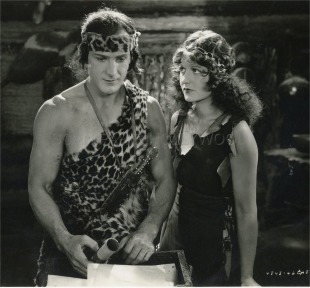
HUMBLE HOMAGE
May 20: On this day in 1923, Edgar Rice Burroughs began writing “Tarzan and the Ant Men.” He finished the 86,000 word novel in 184 days on November 22, 1923. That’s less than 500 words a day. Doesn’t seem like much output, but try it sometime. It was first published in seven episodes by Argosy All-Story Weekly. The first installment had a cover by Stockton Mulford. A.C. McClurg published the first edition of 10,000 copies in September 1924.
The 10th Tarzan novel was subsequently published by Grosett & Dunlap in regular and a wartime editions. A Better Little Book with a John Coleman Burroughs cover reprinted the Rex Maxon newspaper comic version of the novel. Over a span of more than thirty years, Ballantine published copies of the book with covers by Richard Powers, Robert Abbett, Boris Vallejo, and Charles Keegan. Frank Frazetta did a cover for an anticipated, but never released Ace book edition. Several foreign editions have been published over the years. It’s a shame that the book has never been made into a movie.
Today’s Edgar Rice Burroughs drabble is a non-existent conversation. Here’s “Humble Homage.”
![]()
HUMBLE HOMAGE
“No dear, my Ant Men are about two feet tall. Lilliputians
are 6 inches tall.”
“A distinction without a difference.”
“Joan, every writer takes inspiration from those who
wrote before him. Other writers make a living writing stories based on
my work.”
“So, like Isaac Newton, you stand on the shoulders
of giants?”
“Not giants, in this case, more like marching with
Munchkins.”
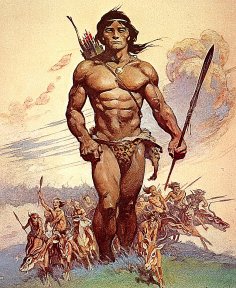
LOST IN TRANSLATION
May 21: On this day in 1999, Vanessa Brown, who played Jane opposite Lex Barker in “Tarzan and the Slave Girl,” died in Woodland Hills, California. Her given name was Smylla Brind and she was born in Vienna, Austria. Of Jewish descent, her family fled to Paris in 1937 to escape persecution by the Nazi regime.
She was fluent in several languages and was graduated from UCLA. Brown's IQ of 165 led to two years of work as one of the young panelists on the radio series “Quiz Kids.” On Broadway, she originated the role of "The Girl" in “The Seven Year Itch,” the character portrayed by Marilyn Monroe in the 1955 film. Sol Lessor interviewed Marilyn for the Jane role in “Tarzan and the Slave Girl,” but selected Vanessa Brown instead.
The film’s director, Lee Sholem found her pompous. He said, “There was a situation one day where she had about three words to say, and she asked, "What is the underlying meaning of this?" In a Tarzan picture! "What is my feeling here? What is my attitude?" Oh, you never heard such shit! “
Brown has two stars on the Hollywood Walk of Fame, a motion pictures star at 1621 Vine Street and a television star at 6528 Hollywood Boulevard. She is credited with the quote, “I think it’s so important to feed your brain, you know. Sometimes you’ve just got to read.”
Today’s Edgar Rice Burroughs inspired drabble is “Lost In Translation.”
LOST IN TRANSLATION
Vanessa Brown responded, “What’s my motivation.”
“Help is your motivation. You don’t want the lion to eat you. Okay.”
“Perhaps, I could use another language. “Ayuadame, Aidez moi, Hilf mir, or even Padek man.” That’s Spanish, French, German and Lithuanian.”
“Tarzan doesn’t speak those languages.”
“In the novels, he’s fluent in French.”
“This isn’t one of the novels. On an RKO set, Tarzan
speaks ape and a little English.”
“Comme toi. Quelle tristesse.”
“What did you call me?”
“Nothing. I said, “As you say. How sad.”
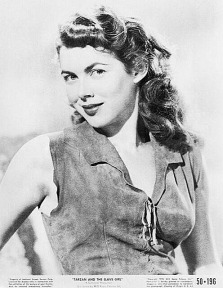
TRIBAL HUNTING SONG
May 22: On this day in 1939: The Official Guide to the Tarzan Clans of America. The 32-page booklet includes "a table of contents, rules and instructions for forming a new clan group, duties of procedures at meetings, initiation ritual, a Tarzan Pledge and Tarzan 'Clan Grip,' lyrics to four songs (but no melodies provided), a section on sports and games, and a 500-word Ape-English Dictionary."
The cover illustration is by John Coleman Burroughs. According to Hulbert Burroughs in a 1962 letter to Henry Hardy Heins, The Ape Dictionary, "cannot be regarded as a dictionary of 'classical ape' since in an effort to provide a larger vocabulary for the Clan members' use and enjoyment, Mr. Burroughs included in it a sizeable number of words from the language of Pal-ul-don -- thus creating a sort of 'Pidgin Ape'."
The Tarzan Clans of America was ERB's version of a boys' club similar to the Boy Scouts of America. Burroughs probably wrote all of the booklet. The Clan's yearly $1.00 membership fee gave each member the booklet, a membership card, and the latest ERB, Inc. first edition (autographed). Movie Tarzan, Johnny Weissmuller, was the "Chief of Chiefs. Such a bargain. Tarzan Clans of America never caught on. Perhaps it was a victim of the last days of the great depression or the first days of WW2, maybe both.
The drabble for today is “Tribal Hunting Song,” and it’s taken directly from page 20 of the Official Guide. Horta is a wild boar.
![]()
TRIBAL HUNTING SONG
We are Warriors of the Clan;
In the jungle we are hunting
Fearing neither beast nor man,
Hunting Horta. Hear him Grunting!
Chorus between verses.
Oh, men of the jungle are we,
The Jungle far over the sea.
Without and care and is free as the air
We live with the apes in a tree.
Horta charges! We are ready.
Gleaming tusks are sharp and long.
Draw the bow. Hold spear had steady!
Horta’s quick and Horta’s strong.
Kreeg-ah! Kree-ah! All together!
Loose the arrow! Cast the spear!
We shall have both food and leather
We the warriors without fear.
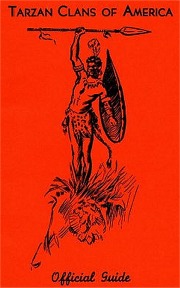
May 23: On this day in 1913, Edgar Rice Burroughs submitted “Tarzan of the Apes” to Rand McNally. Some editor whose name is mercifully lost to history, made the decision to reject the novel. After all, it was only a pulp adventure story and had been written by an unknown writer. After all, they didn’t expect a story like “Tarzan” to compete with the “New Automobile Road Map of New York City and Vicinity,” or their bestseller, “The Locust Plague in the United States.” They also published “Robinson Crusoe,” “Kon-Tiki,” and some “Little Lulu” comic strips.
Harry Beach Clow, Andrew McNally’s son-in-law, was President of the company at that time. But hey, if you want to read “The Real Mother Goose,” consult a good printed map because your cell phone or GPS isn’t working or want to look up something in an actual dictionary, they're your go-to people!
“Tarzan of the Apes”, the third novel written by Burroughs, was eventually published by A.C. McClurg and Co. It has never been out of print since and has sold millions of copies. Rand McNally tried to make the switch to digital technology in the early 2000s, but fell behind the technological curve and filed Chapter 11 bankruptcy in 2003. The company has changed hands twice since then, but still survives to this day.
“In Retrospect” is today’s Edgar Rice Burroughs inspired drabble.
IN RETROSPECT
Andrew looked at the carbon copy. “I don’t know. I was a child in 1913.”
“My eyes aren’t what they used to be. Who signed the damn rejection letter?”
‘Uncle, I don’t recognize the signature, but you initialed the page.”
“Harumph, Must have had a good reason.”
“If you say so, but I don’t think we need to consult a map to tell that the company took a wrong turn down a dead end street.”
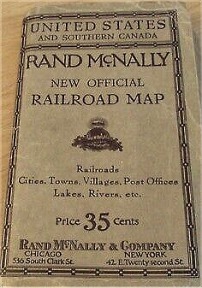
BANDITS AND BODIES
May 24: (n this day in 1924, Edgar Rice Burroughs completed the 81,000-word western novel, “The Bandit of Hell's Bend.” – He wrote the story at the request of England's Sir Algernon Methuen. Algernon Marshall Stedman Methuen, a self-proclaimed Baronet, was born as Algernon Methuen Marshal Stedman and for some reason rearranged the order of his names. Methuen published Rudyard Kipling’s “Barrack-Room Ballads,” as well as works by Hilaire Belloc, Robert Louis Stevenson, and Oscar Wilde.
Burroughs finished “Bandit” in May of 1924 and Methuen died on September 20, 1924. Argosy began serializing “The Bandit of Hell’s Bend” on September 13, 1924 and the second installment was published on September 20, the day of Methuen’s death. It’s possible that Burroughs sent a copy of the manuscript to Algernon, but if he didn’t, the old Baronet never got to read the story he requested. He might have received the first installment of the Argosy pulp, but it’s doubtful. The magazine was dated 9/13 and it would have had to be published and mailed to England – a process that in 1924, surely took longer than a week. Methuen and Company Ltd. Published the British edition of the book in 1926.
Working titles were "The Black Coyote" and "Diana of the Bar Y." I like “The Bandit and Hell’s Bend” better than either of those.
“Bandits and Bodies” is today’s Edgar Rice Burroughs inspired drabble. It references two of Edgar Rice Burroughs’ novels. One is obviously “The Bandit of Hell’s Bend” and the other novel, well, the other novel is a little better known. I apologize to folks that don’t make the connection, because without it, this drabble will make absolutely no sense.
![]()
BANDITS AND BODIES
The mountains were riddled with caves and abandoned mines where men’s search for riches had met with failure in years gone by. Bull said, “Search the mines.”
Shorty crawled out of a mine and said, “No bandits in here, but there’s a mummified woman covered with spider webs and some dead men hanging from the ceiling. Don’t go inside, the air is bad, it made me dizzy.”
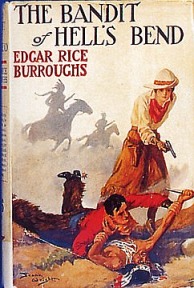
LIFE AFTER THE JUNGLE
May 25: On this date in 2016, Scott Tracy Griffin's magnificent book, "Tarzan on Film" debuted at the monthly meeting of the Orange Country Science Fiction Club. In this authoritative volume, writer and historian Scott Tracy Griffin traced the development of the history-making Tarzan franchise, from the motion-picture industry’s early silent films and serials, through the high point of the Metro-Goldwyn-Mayer era featuring Johnny Weissmuller and Maureen O’Sullivan, to modern worldwide hits like “Greystoke: The Legend of Tarzan, Lord of the Apes” and Walt Disney Studios’ animated “Tarzan.”
Each film has a large, usually a full page image of a poster for the each film. They are all wonderful in their own way, tracing the history of movie posters from the era of silent films and serials all the way to contemporary filmmaking. In addition, there are gorgeous, high-quality photos throughout the book.
The 224 page book was published by Titan Books. The printing quality is outstanding. The posters and photographs are vivid, crisp, and clear. You can almost hear Weissmuller’s yell.
The drabble for the day is “Life After the Jungle.”
LIFE AFTER THE JUNGLE
“I also did “Tarzan, The Epic Adventures.” You find
work after Tarzan?”
“Numerous series and movies.”
“I remember “Sharkopus vs. Whalewolf.”
“Be nice. “Watch Over Me” is syndicated worldwide.
And you?”
“I made films in the Philippines, Bulgaria, Russia,
Czech Republic, Africa, and Mexico.”
“You really made films in Russia and Bulgaria?”
“Yes.”
“Na Zdorovie.” Cheers.”
“I’d wish you good health right back, but I don’t
speak Whalewolf.”
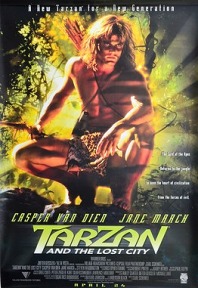
NO FREE SPINS
May 26: On this day in 2011, “Tarzan® Lord of the Jungle™,” the slot machine game, made its debut at Wynn Las Vegas. Cartoon-styled graphics, amazing animations and incredible bonus features are just a few reasons why you should swing between trees with everyone’s favorite jungle hero.
Named after the eleventh novel in the original series written by Edgar Rice Burroughs, the Tarzan: Lord of the Jungle slot machine looks and sounds sensational. The 3x5 game matrix of Tarzan: Lord of the Jungle has been set against a picturesque view of the jungle, which showcases a fast-flowing waterfall and dense vegetation. Above the reels, you’ll see four progressive jackpot counters – Mini, Minor, Major and the life-changing Grand Jackpot – which increase in value with every spin. The jungle setting is reinforced by the rhythmical beats of bongo drums echoing out from the cabinet’s surround sound system during every spin. A quick internet search will reveal several sites where “Tarzan® Lord of the Jungle™,” the slot machine can be played online if anyone is so inclined.
Today’s drabble, “No Free Spins,” is inspired by Edgar Rice Burroughs and is brought to you courtesy of the gaming industry.
![]()
NO FREE SPINS
“Yes, this is the new updated version of “Tarzan, Lord of the Jungle. Awesome graphics. It’s fun.”
“Are you winning?”
“No, I’m down about two hundred bucks. I’m due for a big payoff.”
“Why do you think that?”
“The animated Tarzan winked at me when he did the jungle yell.”
‘John, those websites program the online games so they can’t lose.”
“That’s not true. That would be cheating. They wouldn’t do that.”
“Right, and elves make free shoes. Let me know when you’ve maxed out your Visa. I’ll buy lunch.”
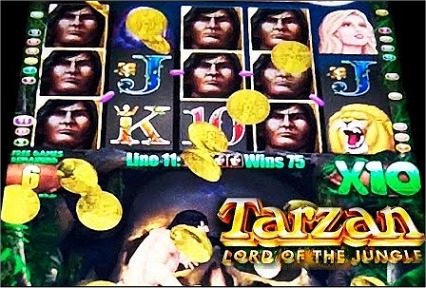
WE DON'T NEED NO STINKING COPYRIGHT
May 27: On this day in 1954, Mark Wheatley, illustrator, writer, editor, and publisher was born. He has won the Inkpot, Speakeasy and Mucker awards, and has been nominated for the Harvey and Ignatz awards for his comic book and pulp creations that include 'Breathtaker', 'Radical Dreamer', 'Frankenstein Mobster', 'Hammer Gods', 'Mars', 'Jimgrim and the Devil at Ludd' and 'Titanic Tales'. His illustration work has also appeared in magazines, books, comic books, games, and ERB fanzines such as The Panthan Journal.
Recently, he illustrated and produced the book, “Songs of Giants,” containing poetry by Edgar Rice Burroughs, Robert E. Howard, and H. P. Lovecraft. His illustration for the dust wrapper of Christopher Paul Carey’s “Swords Against the Moon Men” is simply magnificent. (The book is pretty damn good too.)
Today’s drabble is intended in good humor. As always, Pat and John are based on old friends. It’s a conversation that never took place. It’s called, “We Don’t Need No Stinking Copyright.” A fellow writer submitted a new Peter Pan story to a publisher a couple of months back and received a quick rejection letter that included the following information.
Great Ormond Street Hospital (GOSH) claims that U.S. legislation effective in 1978 and again in 1998, which extended the copyright of the play script published in 1928, gives them copyright over "Peter Pan" in general until 2023. He called me and complained "That isn't fair. That hospital is hardly using the copyright." Alright then. Here's the drabble.
![]()
WE DON'T NEED NO STINKING COPYRIGHT
“This is John and Pat. We got our copies of “Songs of Giants” today. Great artwork. We’ll let you illustrate our book.”
“Very kind. What book is that?”
“Tarzan and Conan Against Cthulhu on Mars.”
“Sounds interesting. Is it written?”
“No.”
“You’ll need permission from the copyright and trademark holders.”
“Pat yelled at John. “I told you. I bet we can’t use Indiana Jones or Luke Skywalker either.”
John replied, “I’ve got another idea using Tangor and Captain Picard. It’s called “Encounter at the Farthest Starpoint.”
Mark said, “Let me know how that works out.”
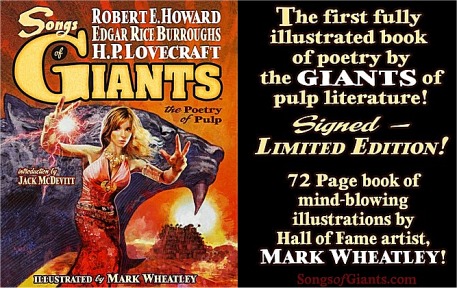
TARZAN, THE GLADIATOR
May 28: On this date in 1929, Edgar Rice Burroughs signed the contract with Metropolitan Books for the publication of “Tarzan and the Lost Empire.” This was the first Edgar Rice Burroughs’ novel not published by A.C. McClurg. The 66,000 word book was 313 pages long.
The novel was written during March, April, and May of 1928 and the working title was “Tarzan and the Lost Tribe.” Tarzan’s monkey companion, Nkima, made his first appearance in this novel.
I never cared for the Armstrong Sperry cover art on the Metropolitan edition. I liked the artwork on the 1951 Dell Mapback, but my favorite is from the Japanese edition of the book, and that cover, painted by Motoichiro Takebe, is included here.
The drabble for today, “Tarzan, the Gladiator,” is taken directly from the cover blurb of the Ballantine paperback edition of the novel.
![]()
TARZAN, THE GLADIATOR
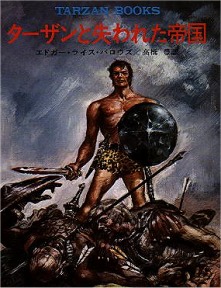
TIME IN MY POCKET
May 29: On this day in 1915, “All-Story Weekly” published the fifth installment of “Pellucidar.” The issue’s cover has an illustration for the first episode of the Janes B. Hendryx novel, “The Promise,” – “A Great Serial About the Man Who Kept His Word.” I think the man on the cover is fighting a white wolf, but it could be a skinny polar bear.
James Beardsley Hendryx wrote hundreds of pulp adventures, including 40 novels. Many featured the character, Black John Smith, the leader of the criminal society in and around Halfaday Creek, a mining community so named because the miners work half a day and play poker half a day. All of his stories were westerns.
As a boy Hendryx liked to hunt and fish, often with his good friend Claude Lewis. Claude, who later became a well-known surgeon, had a younger brother everybody called Red. Red would sometimes make a nuisance of himself by wanting to tag along with the two older boys. Red Sinclair, better known to us as Sinclair Lewis, went on to become a pretty famous writer. When once asked by Claude what was the difference between his writing and Sinclair's, Hendryx replied "The difference is that Red gets a dollar a word, and I get a penny a word.”
“Time in my Pocket” is the Edgar Rice Burroughs inspired drabble for today.
![]()
TIME IN MY POCKET
Hooja shrugged, “What’s high time?”
It means it’s about time for things to get done properly.”
“Things happen when they’re ready. I don’t know this time.
”“Time is the indefinite continued progress of existence and events that occur in an apparently irreversible succession from the past, through the present, into the future.”
“Big words, no message.”
Perry held out his pocket watch. “This tells me when
to do things.”
“Seems silly. I don’t need a golden necklace to tell
me what needs to be done.”
BAR APES
May 30: On this date in 1899, Ethel Dwyer was born in Tarrytown. New York. Her name is rarely mentioned in discussions about actresses who played Jane, but she played as legitimate a Jane as anyone else. She starred opposite Ronald Adair in the 1921 Broadway stage play, "Tarzan of the Apes." She received good reviews in New York newspapers, but the play ran for less than a month. After Tarzan, she appeared with Leo Carrillo on Broadway in the play, “Lombardi Limited.”
Born Ethel Selina Dwyer, she starred in the films “Ten Nights in a Bar Room,” Cotton and Cattle,” “Abie’s Irish Rose,”and “The Cowboy Ace.”
The drabble for today is “Bar Apes.”
![]()
BAR APES
Ethel Dryer smiled. “In going to Hollywood, I’ll be filming, “Ten Nights in a Bar Room,” based on the Tim Shay Arthur novel. There’s only one difference between a bar room and the jungle.”
“Really?”
“You meet a better class of apes in the jungle. Bar
room apes are jerks who only pretend to be nice. I’d rather spend months
with a jungle ape than a minute with one of those apes that a girl meets
in a bar.”
MISPRONUNCTIATION
May 31: On this day in 1932, Edgar Rice Burroughs commented on the newly released film, “Tarzan the Ape Man,” featuring Johnny Weissmuller and Maureen O’Sullivan.
Edgar Rice Burroughs wrote today’s drabble, “Mispronunciation,” and his spelling of Maureen O’Sullivan's name has been left unchanged.
![]()
MISPRONUNCTIATION
![]()
See Days 1-15 at ERBzine
7155
![]()
APRIL IIa ILLUSTRATIONS COLLAGE
![]()
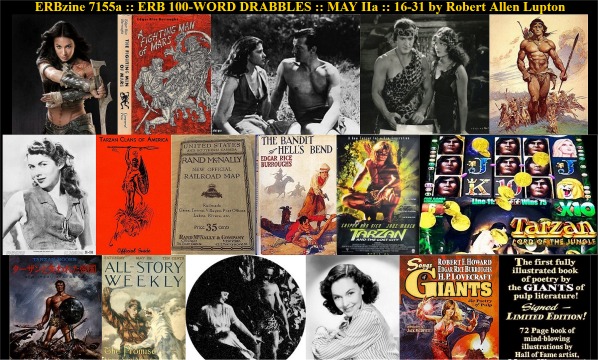
Click for full-size promo collage
![]()
